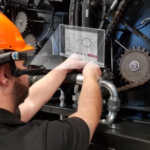DE-ESCALATION TRAINING OVERVIEW
De-Escalation training is a form of soft skills training with the goal of taking heated situations and calming them down. It’s gotten a lot of attention these days in many spaces but can vary in ways many people don’t expect.
Even everyday customer service experiences require the use of de-escalation tactics, and with advancements in the field, the scope of which these training experiences are being executed is growing every day.
For a more comprehensive overview of this topic, make sure to check out our blog outlining everything you need to know about the basics of de-escalation training.
But, de-escalation training doesn’t have to just take place in a classroom. Virtual Reality provides an opportunity to place learners directly into situations just like what they experience in the real world.
So let’s go over how this technique is being taught in VR.
LAW ENFORCEMENT’S USE OF VR DE-ESCALATION

Photo courtesy of Christopher Dornblaser of Bucks Country Courier Times
Police interactions are one of the most obvious and ready-to-deploy types of de-escalation training. From as early as Virtual Reality’s conception, companies have been teaching Law Enforcement new tactics using VR headsets. Initially, these typically involved things like shooting ranges and proper positioning in the field.
Over the next few years though, these simulations grew in complexity. More advancements were made in VR development practices, and eventually, full encounters could be simulated using these headsets.
Sure, a teacher could pretend to be a stranger in an alley looking shady after a reported robbery, but it’s very different once you’re in that alleyway and can barely see where the individual has their hands.
Now, VR experiences fully simulate these encounters and adapt the way that virtual suspects react based on an officer’s actions. Minute things like body language and eye contact can be tracked and used to assess how prepared an officer is to get in the field and deal with these situations.
Not to mention, most modern headsets are fully mobile, meaning there’s no need to lug around a whole computer setup and multiple cameras to track people in VR. Instead, all you need is a headset and proper equipment that communicates with the headset.
An example of this equipment is a separate tablet controlled by a trainer that communicates with the headset wirelessly. These tablets can change the environment, reactions from the avatar in the digital space, and much more. This gives a level of fidelity and power that is only achievable in VR and provides an understanding of a situation that’s second to none.
Modern systems can add real hands, weapons, and more into the virtual experience. This makes it easier than ever to deploy training in the field.
CUSTOMER SERVICE HELPING EVERYDAY ISSUES

Photo courtesy of Adi Robertson of The Verge
Customer service is another large axle in the de-escalation wheel. Prime examples include things like retail service desks and call centers with thousands of inbound calls. When customer stress is combined with long wait times, escalation is common.
It’s one thing to calm someone down over the phone, but it’s a whole nother story in person. Quick eyerolls or slight shifts in the body can turn what could’ve been a quick interaction into a mess. This is where VR Training can be a huge boon for preparing customer-facing employees.
In 2018, Walmart took advantage of Virtual Reality in preparation for an upcoming Black Friday. Their VR experience put employees in the heat of the action. Surrounded by moving crowds, limited item stock, and nothing separating the trainee from overzealous shoppers.
One thing that worked well on this project was its reach. Walmart sent over 17,000 headsets to over 4,700 US Stores, giving each location the ability to train their staff on their time. The creators of this training app knew every person that went through the experience would experience it exactly as it was designed. Employees could easily take off the headset and pass it to another coworker without any setup time, and VR is always a fun tool to pass around.
Again, it’s one thing to prepare for these situations in a classroom, but nothing beats seeing all these moving parts in action. That’s how you take something that could be an hour-long class of PowerPoints into an experience that is hard to forget.
HOSPITALS AND HEALTHCARE

Photo courtesy of Cedars Sinai and GIBLIB
Frontline workers in the Healthcare industry also need de-escalation skills. There may not be enough rooms for everyone, and balancing how to deal with this during peak times is essential. They need actionable strategies for communicating with families that may have been waiting for hours.
A lot of this can come down to situational awareness – which is a challenge to learn. Traditional classroom training teaches facts and appropriate actions, but not behavioral skills. You can know all the correct steps to take, but once you’re in the heat of the moment, it’s easy to overthink it. It takes exposure and active practice for someone to be fully situationally aware.
Virtual Reality can empower frontline workers to have confidence in how they deal with these situations. Simulations can place a trainee in the action, allow them to react how they would, and review their reaction all in a single session. They can also be crafted to adapt in intensity based on what the trainee is doing, adjusting to make an experience truly beneficial.
AVIATION SAFETY AND FLIGHT ATTENDANT CONFIDENCE

The airline industry has been researching uses for VR Training for years. Traditionally, this involved things like plane inspections. Employees could check around planes for debris, and review the inside of a cabin for dangerous items, all without having to use a real plane.
However these days, soft skills training is a primary focus of growth. Starting before even leaving the ground, gate agents offer a great opportunity for Virtual Reality training. Whether it’s rescheduled flights or lost tickets – confrontations are a common occurrence.
While these situations can be tense, often what’s occurring can be a lack of communication. Virtual Reality can provide a framework to practice different communications strategies that keep everyone content.
Yet this isn’t always so clear cut. Flight attendants often have a lot to deal with during a flight, with things like boarding or while stuck in the air. Lufthansa Cargo tackled this issue in 2019 with a Virtual Reality training experience designed specifically for flight attendants.
Using a VR headset, these flight attendants were instantly placed in virtual cabins while simultaneously being monitored by an instructor via another screen. With this program, Lufthansa has been training over 18,500 flight attendants per year, showing how powerful VR can be once it’s at scale.
None of these problems are new ones. But, new solutions can help flight attendants, desk operators, and safety officers feel confident and comfortable in their work. Virtual Reality has the ability to take the problems, and find solutions that work in ways we were meant to learn.
WRAPPING UP
Whether it be law enforcement strategies, or a daily customer service interaction – de-escalation training is becoming the next big movement in learning and development. Virtual Reality is turning old-school classroom lectures into fully immersive experiences. Limitations of the past are actively being answered with simpler and more powerful headsets – moving the question to, “What can’t we do?”.
Custom-made experiences can be created specifically to meet a company’s needs and shared across an organization. Repeatability is key, and L&D managers can take comfort in the fact that everyone who goes through a VR training will have the exact same experience. No expensive mockups, flights to training conventions, or PowerPoint presentations are needed.
No matter the need, soft skills training using VR is here. We at Foundry 45 fully believe in the future of soft skills VR training. After over 7 years of crafting custom Virtual Reality experiences, we worry about the tech details so our clients can focus on what they know best – the training. If you’re interested in exploring how this technology can help your L&D, please contact us below.
Quelle:


